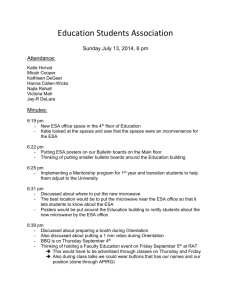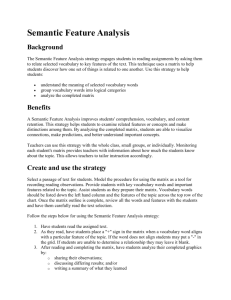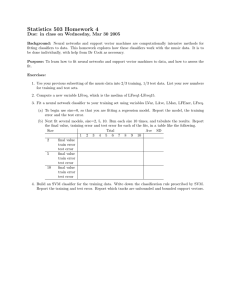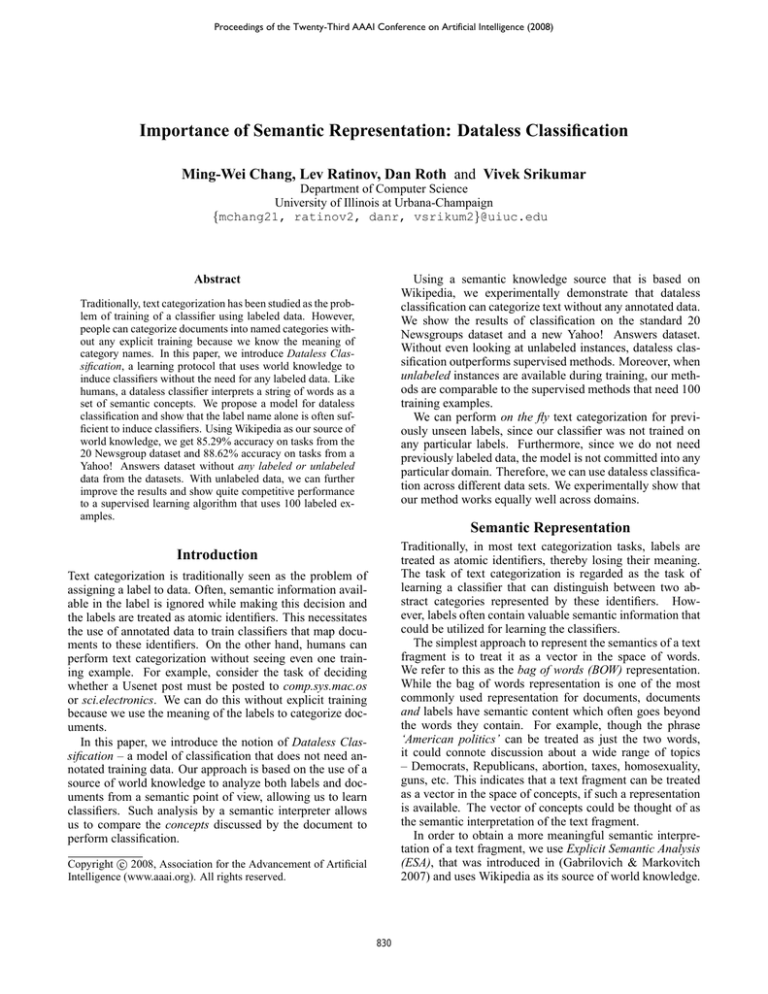
Proceedings of the Twenty-Third AAAI Conference on Artificial Intelligence (2008)
Importance of Semantic Representation: Dataless Classification
Ming-Wei Chang, Lev Ratinov, Dan Roth and Vivek Srikumar
Department of Computer Science
University of Illinois at Urbana-Champaign
{mchang21, ratinov2, danr, vsrikum2}@uiuc.edu
Abstract
Using a semantic knowledge source that is based on
Wikipedia, we experimentally demonstrate that dataless
classification can categorize text without any annotated data.
We show the results of classification on the standard 20
Newsgroups dataset and a new Yahoo! Answers dataset.
Without even looking at unlabeled instances, dataless classification outperforms supervised methods. Moreover, when
unlabeled instances are available during training, our methods are comparable to the supervised methods that need 100
training examples.
We can perform on the fly text categorization for previously unseen labels, since our classifier was not trained on
any particular labels. Furthermore, since we do not need
previously labeled data, the model is not committed into any
particular domain. Therefore, we can use dataless classification across different data sets. We experimentally show that
our method works equally well across domains.
Traditionally, text categorization has been studied as the problem of training of a classifier using labeled data. However,
people can categorize documents into named categories without any explicit training because we know the meaning of
category names. In this paper, we introduce Dataless Classification, a learning protocol that uses world knowledge to
induce classifiers without the need for any labeled data. Like
humans, a dataless classifier interprets a string of words as a
set of semantic concepts. We propose a model for dataless
classification and show that the label name alone is often sufficient to induce classifiers. Using Wikipedia as our source of
world knowledge, we get 85.29% accuracy on tasks from the
20 Newsgroup dataset and 88.62% accuracy on tasks from a
Yahoo! Answers dataset without any labeled or unlabeled
data from the datasets. With unlabeled data, we can further
improve the results and show quite competitive performance
to a supervised learning algorithm that uses 100 labeled examples.
Semantic Representation
Traditionally, in most text categorization tasks, labels are
treated as atomic identifiers, thereby losing their meaning.
The task of text categorization is regarded as the task of
learning a classifier that can distinguish between two abstract categories represented by these identifiers. However, labels often contain valuable semantic information that
could be utilized for learning the classifiers.
The simplest approach to represent the semantics of a text
fragment is to treat it as a vector in the space of words.
We refer to this as the bag of words (BOW) representation.
While the bag of words representation is one of the most
commonly used representation for documents, documents
and labels have semantic content which often goes beyond
the words they contain. For example, though the phrase
‘American politics’ can be treated as just the two words,
it could connote discussion about a wide range of topics
– Democrats, Republicans, abortion, taxes, homosexuality,
guns, etc. This indicates that a text fragment can be treated
as a vector in the space of concepts, if such a representation
is available. The vector of concepts could be thought of as
the semantic interpretation of the text fragment.
In order to obtain a more meaningful semantic interpretation of a text fragment, we use Explicit Semantic Analysis
(ESA), that was introduced in (Gabrilovich & Markovitch
2007) and uses Wikipedia as its source of world knowledge.
Introduction
Text categorization is traditionally seen as the problem of
assigning a label to data. Often, semantic information available in the label is ignored while making this decision and
the labels are treated as atomic identifiers. This necessitates
the use of annotated data to train classifiers that map documents to these identifiers. On the other hand, humans can
perform text categorization without seeing even one training example. For example, consider the task of deciding
whether a Usenet post must be posted to comp.sys.mac.os
or sci.electronics. We can do this without explicit training
because we use the meaning of the labels to categorize documents.
In this paper, we introduce the notion of Dataless Classification – a model of classification that does not need annotated training data. Our approach is based on the use of a
source of world knowledge to analyze both labels and documents from a semantic point of view, allowing us to learn
classifiers. Such analysis by a semantic interpreter allows
us to compare the concepts discussed by the document to
perform classification.
c 2008, Association for the Advancement of Artificial
Copyright Intelligence (www.aaai.org). All rights reserved.
830
Newsgroup Name
talk.politics.guns
talk.politics.mideast
talk.politics.misc
alt.atheism
soc.religion.christian
ESA was originally introduced to measure semantic relatedness between text fragments. Given a text fragment, the
ESA algorithm generates a set of concepts that are weighted
and ordered by their relevance to the input. Here, we provide a brief summary of this approach and refer the reader
to (Gabrilovich & Markovitch 2007) and (Gabrilovich &
Markovitch 2006) for more details.
The main assumption is that each article in Wikipedia corresponds to a concept. To get the ESA representation of
a text fragment, for each word in the text, the interpreter
identifies the concepts that contain it. These concepts are
combined to form a weighted vector, where the weights are
obtained by using the TFIDF representation of the original
text. The list of concepts are ordered by the weight to get
the final ESA representation.
Since Wikipedia is the largest encyclopedic source of
knowledge on the web, ESA representation is sufficient for
many categorization tasks. Additionally, since Wikipedia
was generated by humans, it provides a natural measure of
relatedness between text fragments. Previous research has
shown that semantic interpretation based on Wikipedia is a
more reliable measure of distance between documents than
the traditional bag-of-words approach. In the Discussion
section, we present brief thoughts on why dataless classification works and what makes a resource of knowledge sufficient for this purpose.
In our experiments, we use the BOW and ESA representation schemes for both label names and the documents.
talk.religion.misc
comp.sys.ibm.pc.hardware
comp.sys.mac.hardware
sci.electronics
comp.graphics
comp.windows.x
comp.os.ms-windows.misc
misc.forsale
rec.autos
rec.motorcycles
rec.sport.baseball
rec.sport.hockey
sci.crypt
sci.med
sci.space
Expanded Label
politics guns
politics mideast
politics
atheism
society religion
christianity christian
religion
computer systems
ibm pc hardware
computer systems mac
macintosh apple hardware
science electronics
computer graphics
computer windows x
windowsx
computer os operating
system microsoft windows
for sale discount
cars
motorcycles
baseball
hockey
science cryptography
science medicine
science space
Table 1: Newsgroup label names. We expanded the names
of the newsgroups to full words and removed some words
like misc. This table lists the expanded newsgroup names.
Data and Experimental Methodology
Yahoo! Answers The second dataset that we used for our
experiments is based on Yahoo! Answers and was collected
for these tasks.1 We extracted 189,467 question and answer
pairs from 20 top-level categories from the Yahoo! Answers
website (that is, about 10,000 question/answer pairs per category). These top-level categories have a total of 280 subcategories which refine the labels, though the distribution of
question/answer pairs at the subcategory is not uniform. Table 2 shows a sample of category and subcategory names.
For our experiments, we used the original category and subcategory names as label names.
To evaluate our ideas, we need datasets where the labels contain rich semantic information. Here, we describe the two
datasets that we used.
20 Newsgroups Dataset The 20 Newsgroups Dataset is
a common benchmark used for testing classification algorithms. The dataset, introduced in (Lang 1995), contains approximately 20,000 newsgroup posts, partitioned
(nearly) evenly across 20 different newsgroups. Some of
the newsgroups are very closely related to each other (e.g.
comp.sys.ibm.pc.hardware and comp.sys.mac.hardware ),
while others are unrelated (for example, misc.forsale and
soc.religion.christian ). The 20 topics are organized into
broader categories: computers, recreation, religion, science,
forsale and politics. This dataset has been used for many
learning tasks (Raina, Ng, & Koller 2006; McCallum et al.
1998).
Since our approach uses the content of label names, good
label names are essential for the performance. We cleaned
the existing labels by expanding the newsgroup names that
were used in the original data. For example, we expanded
os into operating system and mac to macintosh apple. We
also removed irrelevant words – misc, alt, rec and talk. The
amended label names given for each class are summarized in
Table 1. This amendment is necessary because the existing
labels are sometimes not real words or, as in the case of for
sale, the expansion contains a stop word, which necessitates
further expansion.
Top-level Category
Arts And Humanities
Business And Finance
Business And Finance
Computers And Internet
Consumer Electronics
Entertainment And Music
Games And Recreation
Sports
Sports
Subcategory
Theater Acting
Advertising Marketing
Taxes
Security
Play Station
Jokes Riddles
Video Online Games
German Football Soccer
Rugby League
Table 2: Sample Yahoo! Answers categories and subcategories. In all, we collected 20 top level categories and 280
subcategories from Yahoo! Answers.
1
831
Please contact the authors for the Yahoo! Answers data.
Id
1
2
3
4
5
6
7
8
9
10
Problem
Motorcycles Vs Ms-Windows
Baseball Vs Politics.misc
Religion Vs Politics.guns
Atheism Vs Autos
IBM hardware Vs Forsale
Politics.mideast Vs Sci.med
Christianity Vs Hockey
Space Vs Mac.Hardware
Windows.X Vs Electronics
Sci.Cryptography Vs Comp.graphics
Dataset
Newsgroups
Yahoo
17
18
19
20
65.73
66.79
85.29
88.62
Classification with no data
(Raina, Ng, & Koller 2006) used the 20 Newsgroup dataset
to construct ten binary classification problems, shown in Table 3. We used these problems for our experiments. In
(Raina, Ng, & Koller 2006), they use a logistic regression
classifier. As our supervised baseline, we trained a naive
Bayes classifier using 10 labeled examples and observed
similar accuracies.
For the Yahoo! Answers dataset, we generated 20 random binary classification problems at the subcategory level.
Some of these problems are shown in 4. We report the average performance over all the problems and then focus on
specific cases which highlight the strengths and weaknesses
of our approach.
Intuitively, these are ‘easy’ classification problems for humans. However, with 10 training samples, (Raina, Ng, &
Koller 2006) reported the error rates as high as 20% in 8 out
of 10 problems, and even with 100 labeled samples, the error rate on the religion vs. politics.guns problem was above
20%. Using the on-the-fly classification technique described
in the next section, we achieve error rates below 11.5% on 9
out of 10 problems with no labeled data at all.
16
NN-ESA
On-the-fly Classification
Experimental Methodology
15
NN-BOW
Table 5: Average accuracy of dataless classification with the
bag of words and ESA representations on the Newsgroups
and Yahoo! Answers datasets. Note that in both domains,
the use of ESA representation is better than using just the
words of the labels and no other training data. In fact, the
ESA representation, without any training data outperforms
supervised naive Bayes classifiers which use ten labeled examples.
Table 3: The set of 10 binary classification problems used in
(Raina, Ng, & Koller 2006) for the 20 newsgroups data.
Id
..
.
14
Supervised
Baseline
71.71
84.34
We use the term “on-the-fly classification” to refer to the
situation where category names are not known in advance
and hence, no training can be done. Essentially, on-thefly classification is a technique for classifier induction that
does not use any data at all and uses no knowledge of the
datasets either. We show that with no data other than the
label names, we can get very good performance for classifying documents. The efficacy of this approach stems from
the rich semantic representation discussed earlier. In order
to demonstrate the effectiveness of the semantic representation, we use a very simple classification technique – we perform Nearest Neighbors classification on an appropriately
selected feature space. Let ϕ(t) denotes some vector representation of text t. For a document d and labels li , we pick
the category i if arg mini ||ϕ(li ) − ϕ(d)||.
Using the Bag of Words (BOW) representation, which
represents text fragments as vectors in the space of words,
we get the NN-BOW classifier. The ESA representation
represents text as vectors in the space of concepts. Using
the ESA representation gives us the NN-ESA classifier.
Results
Description
..
.
Health Diet Fitness
Health Allergies
Business And Finance Small Business
Consumer Electronics Other Electronics
Consumer Electronics DVRs
Pets Rodents
Business And Finance India
Business And Finance Financial Services
Sports Mexican Football Soccer
Social Science Dream Interpretation
Sports Scottish Football Soccer
Pets Horses
Health Injuries
Sports Brazilian Football Soccer
The results of dataless classification on the binary categorization tasks for the Newsgroups and the Yahoo! Answers
datasets are summarized in Table 5. It is clear that the NNBOW algorithm can classify documents correctly only if the
document contains words that appeared in the label names.
Therefore, the recall of this method is quite limited. We can
see NN-ESA performs much better than bags of words approach. This implies NN-ESA can categorize of documents
even if they share no common words with the label name.
Since the ESA representation maps a text snippet into highdimensional semantic space, two documents may be very
close in the ESA space even if they share no common terms.
This results in an on-the-fly classifier that can use dynamic,
ad-hoc labels.
In Table 5, we also show as baseline, the performance of
a supervised naive Bayes classifier that was learned with ten
examples. We can see that with both the Newsgroups and
Yahoo! Answers datasets, the NN-ESA classifier outperforms the supervised classifier.
Table 4: Sample binary categorization problems for the Yahoo! Answers dataset – subcategory level
832
Semantics of Unlabeled Data
Algorithm 2 Co-training We use the fact that BOW and ESA can
independently classify the data quite well to induce a new classifier.
Modeling Unlabeled Data
1:
2:
3:
4:
5:
6:
7:
8:
9:
In the previous section, we show that even without knowing anything about the data, a rich semantic representation
can perform on par with supervised methods. However, often we have access to unlabeled documents belonging to the
problem of interest. This allows us to take advantage of previous work in semi-supervised learning (Refer, for example,
(Nigam et al. 2000)).
Bootstrapping A straightforward extension of the on-thefly scheme is to bootstrap the learning process with only the
label names as examples. Algorithm 1 presents the pseudocode for learning a bootstrapped semi-supervised classifier
using a feature representation ϕ. Note that though we do
perform training, we still do not use any labeled data and
use only the label names as the starting point in the training.
(Steps 1 to 4 indicate this.) Using the BOW and ESA representations with this algorithm gives us the BOOT-BOW and
BOOT-ESA classifiers respectively.
10:
11:
12:
13:
14:
Results
The performance of the different algorithms with the Newsgroup and Yahoo! Answers datasets is summarized in Table .
Additionally, we also show the performance of a supervised
baseline system that used a naive Bayes algorithm with 100
training examples. We can see from the table that both the
BOOT-ESA and Co-train classifiers are competitive with
the supervised classifier. Even the BOOT-BOW classifier is
comparable to the supervised baseline. This indicates that
using unlabeled data, we can train very strong classifiers if
we use the semantics of the labels.
Algorithm 1 Bootstrap-ϕ. Training a bootstrapped classifier for
a feature representation ϕ, where ϕ could be Bag of Words or ESA.
1:
2:
3:
4:
5:
6:
7:
8:
9:
10:
11:
Let training set T BOW = ∅,T ESA = ∅.
for all labels li do
Add li to both T ESA and T BOW with label i
end for
repeat
Train a naive Bayes classifier N B BOW on T BOW .
Train a naive Bayes classifier N B ESA on T ESA .
for all di , a document in the document collection do
if Both N B BOW and N B ESA classify di with
high confidence then
Add di to T BOW with label from N B BOW
Add di to T ESA with label from N B ESA
end if
end for
until No new training documents are added
Let training set T = ∅
for all labels li do
Add li to T with label i
end for
repeat
Train a naive Bayes classifier N B on T
for all di , a document in the document collection do
If y = N B.classif y(ϕ(di )) with high confidence
Add di to T with label y
end for
until No new training documents are added.
Discussion
Our results have showed that using a good representation
can have a dramatic impact on classification. In this section,
we discuss when and why simply using the label name is
sufficient for classification and provide a justification for our
method. Our goal is to develop an understanding of what
makes a dataset a good semantic resource, so that it will be
possible to apply our framework using resources other than
Wikipedia.
Let W be the set of all words. Consider a classification
task in which the categories are c1 , c2 , . . . , cm . We assume
that there exist collections G1 , G2 , . . . , Gm of words that are
‘good’ for these categories. Informally, we interpret ‘good’
to have a discriminative meaning here. That is, a word is
‘good’ for ci if it is more likely to appear in ci -documents
than in documents of other categories.
The notion of ‘good’ directly relates to a key assumption about the relation between category labels and the semantic knowledge resource that we use (in our experiments,
Wikipedia). Specifically, if a user chooses l to be a label
of a category c, and thus thinks that l is a ‘good description’ of the category, it means that Wikipedia articles that
contain l should contain other words that are ‘good’ for c.
Consequently, our approach for generating a semantic representation using l and the Wikipedia articles will bring a
Co-training The classifiers Boot-BOW and Boot-ESA
are learned by bootstrapping on the bag of words and the
ESA representations of the data respectively. The fact that
BOW and ESA are parallel representation of the same data is
ignored. Prior work ((Blum & Mitchell 1998)) has studied
the scenario when two independent feature representations
(or views, as they are called in (Blum & Mitchell 1998))
ϕ1 (d) and ϕ2 (d) are available for the same data and that if
each feature representation is sufficient for correct classification of the data. In such a case, we can train two classifiers
c{ϕ1 } and c{ϕ2 } that classify data better than chance. These
two classifiers can train one another in a procedure called
Co-training. We can apply a variant of this idea for our task.
The algorithm for co-training is summarized in Algorithm 2.
While the ESA representation is a function of the BOW representation, violating the ‘view independence’ assumption,
we show that in practice, this procedure leads to a satisfactory performance. 2
2
We also experimented with concatenating the BOW and the
ESA representations into a single BOW+ESA view as was done
in (Gabrilovich & Markovitch 2005) for supervised classification.
Then we bootstrapped the naive Bayes classifier on the BOW+ESA
view, but it consistently performed worse than co-training.
833
Dataset
Newsgroup
Yahoo! Answers
Supervised
10 Samples
71.71
84.34
Supervised
100 Samples
92.41
94.37
BOOT-BOW
BOOT-ESA
Co-train
88.84
90.70
90.92
92.73
92.70
95.30
Table 6: Performance of classifiers when unlabeled data is available. The supervised baseline, in this case, is a naive Bayes
classifier that is trained on 100 labeled examples. The last three classifiers do not use any labeled examples at all.
Newsgroup name
Christianity
Religon
document that belongs to category c closer to the representation of l, than it would a document that does not belong to
c. Even if the approximation by the label name is not of a
high quality, given a good representation, classifiers can be
discriminating.
Let ϕ(.) be the semantic representation which receives a
document and generates the semantic representation. First,
we assume that the representation is good. This means that
there exits a an oracle document wi for category i such that
all documents that belong to ci are close to wi . More formally,
kwi − ϕ(d)k ≤ kwj − ϕ(d)k − γ, ∀j 6= i
Table 7: The ‘discriminative words’ found by labeled data
of the task Christianity vs. Religion in 20 newsgroup.
this task in Table 7. It is clear that (i) it is difficult to distinguish the document based on these words even for human, and (ii) there are some unrepresentative words which
happened to be ‘good’ in this task. Since it is unlikely we
can find a document in Wikipedia mentions Christianity and
nntp at the same time, it is hard for dataless classification to
perform well. Therefore, it is crucial to the success of the
task is that the ‘good’ words for the specific classification
task should be representative to their label names.
(1)
where γ can be viewed as margin.
Note that our approximation for wi is by ϕ({li }) which
is the representation for the label name of category ci . We
say that the approximation is reasonable, which means the
distance between ϕ({li }) and wi is not too far. Formally,
Dataless Classification for Domain Adaptation
i
kw − ϕ({li })k < η.
The problem of discriminating two concepts across several
domains is an important open problem in machine learning called domain adaptation, which recently has received
a lot of attention (Daumé & Marcu 2006; Jiang & Zhai
2007). In this section, we claim that the semantic representation of documents are ‘universal’ and works across domains.
Therefore, in document classification, universal representation diminishes the necessity of domain adaptation.
In traditional approaches to text categorization, when a
classifier is trained on a given domain, it may not categorize
documents well in a new domain. Informally, the classifier
has learned the vocabulary used to express the category’s
documents in a specific domain because different domains
might use different words to express the same ideas.
On the other hand, using the dataless approach simplifies the problem of domain adaptation. First of all, the label
names are the same from different domains. Furthermore,
documents of the same category from different domains
should project to similar concepts because of the wide coverage of Wikipedia. Therefore, projecting the documents onto
the space of concepts works well across domains. Our interpretation is that semantic representation categorizes documents as belonging to a category based on their meaning
rather than the surface representation.
As our running example, we choose to focus on discriminating documents pertaining to baseball and hockey. The
categorization accuracy with 5-fold cross-validation are 0.97
for the Newsgroup domain, and 0.93 for the Yahoo domain
using BOW approach (training data and testing data are from
the same domain).
The results for domain adaptation are shown in Table 8.
By triangle inequality,
kϕ(d) − ϕ({li })k ≤ kwi − ϕ(d)k + kwi − ϕ({li })k
= kϕ(d) − wi k + η.
Discriminative words
morality, host, nntp, writes, koresh
thanks, quite, assume, clh, rutgers
(2)
Combining (1) and (2), it follows that
kϕ(d) − ϕ({li })k ≤ kwi − ϕ(d)k + η
≤ kwj − ϕ(d)k − γ + η, ∀j 6= i,
≤ kϕ(d) − ϕ({lj })k − γ + 2η, ∀j 6= i
The final step of the above inequality implies that if the
representation is good (that is, if γ is large enough), then η
can be as large as γ/2 without changing the classification result. This justifies the intuition that if the distance between
the categories is large enough in some space, then the approximation that the labels provide for the categories need
not be perfect for good classification performance.
The previous discussion suggests that often, with the appropriate representation, dataless classification is easy since
the categories are far apart. We believe that, often, when
the problem seems to be hard for dataless classification, it
could be due to a very specific definition of a category, that
may be different than the one expressed in our resources
(Wikipedia).
Consider, for example, the difficult pair of Christianity vs.
Religion in the 20 Newsgroup data. We have listed the top
five discriminative words (that is, highest weighted words
for both classes according to a discriminative classifier) for
834
20NG → 20 NG
Yahoo → 20 NG
20NG → 20 NG
Yahoo → 20 NG
∅ → 20NG
Yahoo → Yahoo
20NG → Yahoo
Yahoo → Yahoo
20NG → Yahoo
∅ → Yahoo
Model
Supervised
Supervised
Supervised
Supervised
Dataless
Supervised
Supervised
Supervised
Supervised
Dataless
Features
BOW
BOW
ESA
ESA
ESA
BOW
BOW
ESA
ESA
ESA
Accuracy
0.97
0.60
0.96
0.90
0.96
0.93
0.89
0.97
0.96
0.94
performance of our system. An appealing aspect of ESA is
that it covers a wide-ranging set of topics. However, we
could replace Wikipedia with a different source of world
knowledge and define our semantic interpreter using this
source. For example, in (Gabrilovich & Markovitch 2005),
the authors use the Open Directory Project to construct a
semantic interpreter. Additionally, we could create semantic
interpreters with specialized data sources if we are interested
in categorizing documents related to a specific area.
Acknowledgments
We wish to thank Evgeniy Gabrilovich for providing his implementation of ESA for our experiments. This work was
supported by NSF grant NSF SoD-HCER-0613885 and by
MIAS, a DHS-IDS Center for Multimodal Information Access and Synthesis at UIUC.
Table 8: Analysis for adaptation from Source → T arget
for different domains.
When we applied the NB classifier trained on the BOW representation of 20NG to Yahoo data , the accuracy dropped
from 0.93 down to 0.89, and when we applied the classifier
trained on Yahoo to the Newsgroup domain, the accuracy
dropped down significantly from 0.97 to 0.60. This shows
that the BOW classifiers are very sensitive to data distribution. In contrast, when ESA representation is used instead
of BOW, 5-fold cross validation was 0.96 on 20NG and 0.97
for Yahoo. When the NB classifier trained on the ESA representation of Yahoo documents was applied to 20NG, the
performance dropped only slightly to 0.90. When we applied the classifier trained on ESA representation of 20NG
documents to Yahoo, the accuracy was 0.96.
However, the most significant result is that when we applied the dataless algorithm NN-ESA, presented in Section
(where we used only the label name), the performance was
0.94 on the 20NG dataset and 0.96 on the Yahoo dataset,
which are very competitive with the result by supervised
learning algorithm with in-domain training data.
These results demonstrate the good adaptation properties of the ESA-representation-based approaches in general,
and the dataless NN-ESA approach presented in this paper,
which uses the universal cross-domain semantic information
present in the label to classify data across domains.
References
Blum, A., and Mitchell, T. 1998. Combining labeled and
unlabeled data with co-training. In COLT, 92–100.
Daumé, H., and Marcu, D. 2006. Domain adaptation
for statistical classifiers. Journal of Artificial Intelligence
26:101–126.
Gabrilovich, E., and Markovitch, S. 2005. Feature generation for text categorization using world knowledge. In
IJCAI, 1048–1053.
Gabrilovich, E., and Markovitch, S. 2006. Overcoming the
brittleness bottleneck using Wikipedia: Enhancing text categorization with encyclopedic knowledge. In AAAI, 1301–
1306.
Gabrilovich, E., and Markovitch, S. 2007. Computing semantic relatedness using Wikipedia-based explicit semantic analysis. In IJCAI, 1606–1611.
Jiang, J., and Zhai, C. 2007. Instance weighting for domain
adaptation in NLP. In Proceedings of the annual meeting
of ACL, 264–271.
Lang, K. 1995. NewsWeeder: learning to filter netnews.
In ICML, 331–339.
McCallum, A. K.; Rosenfeld, R.; Mitchell, T. M.; and Ng,
A. Y. 1998. Improving text classification by shrinkage in a
hierarchy of classes. In ICML, 359–367.
Nigam, K.; McCallum, A. K.; Thrun, S.; and Mitchell,
T. M. 2000. Text classification from labeled and unlabeled
documents using EM. Machine Learning 39(2/3):103–134.
Raina, R.; Ng, A. Y.; and Koller, D. 2006. Constructing
informative priors using transfer learning. In ICML, 713–
720.
Conclusions and Future Work
Quite often, classification tasks are defined by specifying labels that carry meaning. Text categorization is a prime example in that the labels identify a category with words that
describe the category. In this paper, we develop the notion of
Dataless Classification that exploits this situation to produce
on-the-fly classifiers without the need for training. Furthermore, using the unlabeled data, we can improve our training
to get highly accurate classifiers without looking at any labeled examples.
We note that, unlike traditional learning, where we need
at least two classes to learn a classifier, the idea of using a
semantic interpreter could be applied to create a one-class
classifier too. For example, we could think of a ‘baseballclassifier’, which identifies documents that discuss baseball.
This bridges the notions of classification and information retrieval.
The semantic interpreter plays an important role in the
835

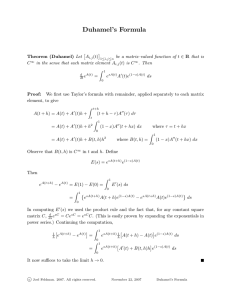
![[ ] ( )](http://s2.studylib.net/store/data/010785185_1-54d79703635cecfd30fdad38297c90bb-300x300.png)
